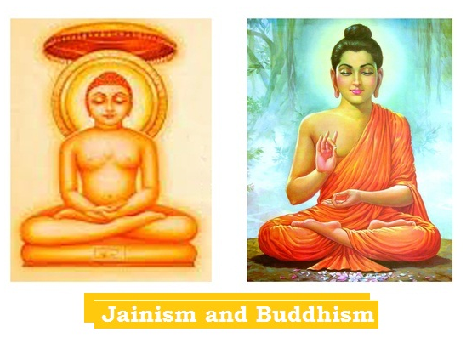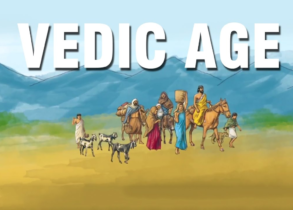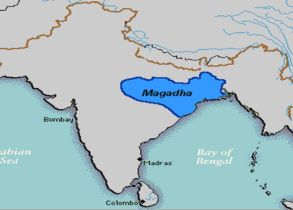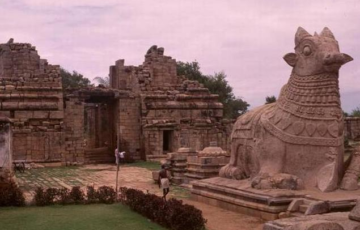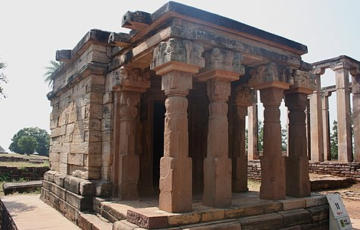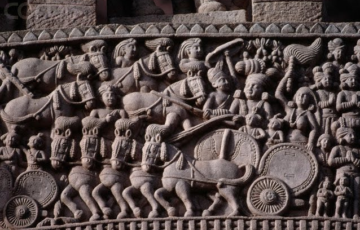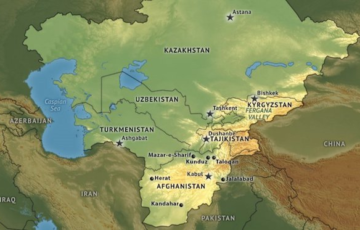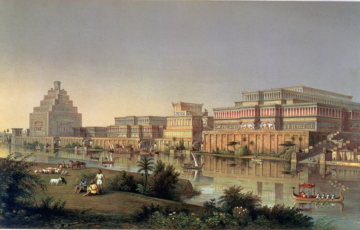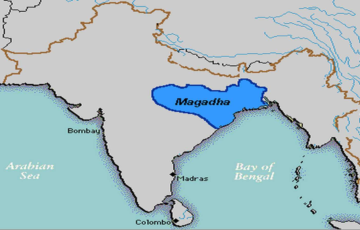BUDDHISM AND JAINISM
| Sources
● Literary sources: Mahabharata, Ramayana, and dharmasastras. ● Buddhist texts like the Tripitakas and Jatakas, Jaina texts, and Greek accounts. ● Archaeological excavations |
Origin of Buddhism and Jainism
Buddhism and Jainism emerged as significant heterodox movements during the post-Vedic era as a response to the Kshatriya opposition against the dominance of Brahmin rituals. They rose for several key reasons:
Increasing skepticism challenged traditional customs and orthodoxies.
- The Vedic tradition’s widespread slaughter of cattle during sacrifices hindered the advancement of the emerging agricultural economy, which relied on cattle for its progress.
- These religions were founded by Mahavira and Buddha.
- Notably, both Mahavira and Gautama Buddha received substantial support from the Vaisya community.
- They advocated non-violence, thereby diminishing the potential for conflicts and promoting trade and commerce.
- The Dharmasutras criticized the practice of lending money on interest, a notion rejected by Buddhism and Jainism.
- Initially, they disregarded the existing varna system, focusing instead on enhancing the status of Vaisyas.
Gautama Buddha and Buddhism
Gautama Buddha or Siddhartha was a contemporary of Mahavira.
- Born in 563 B.C. into the Sakya kshatriya family in a park in Lumbini near Kapilavastu.
- Ashoka erected a pillar at Lumbini to commemorate his visit to the birthplace of Gautama Buddha.
- His father Suddhodhana was the elected ruler of Kapilavastu, leading the Sakya republic and his mother Mahamaya was a princess from the Kosalan dynasty.
- Mahamaya experienced a dream in which a white elephant entered her womb.
- He was brought up by his foster mother “Mahaprajapati Gautami” — first lady (Bhikkhuni) to be included in his Sangha.
- He married Yashodhara and had a son named Rahula.
- One day, while riding in his chariot with his charioteer, Siddhartha Gautama encountered four sights: an old man, a sick man, a corpse, and a religious mendicant. These encounters deeply affected him, prompting his realization of the widespread suffering in the world.
| THE PATH TO NIRVANA
● At 29, he departed the city on a chariot with beloved horse Kanthaka and Channa, the charioteer. This is known as Mahabhiraskramana or the Great Going Forth. ○ He became Alara Kalama‘s disciple, and sought Uddaka Ramaputta‘s guidance. ○ However, he found their path unsatisfactory and engaged in severe austerities, which nearly resulted in his death. ● Afterward, he arrived at Uruvela (now known as Bodh Gaya), situated alongside the Niranjana River (Falgu River). ● Sitting beneath a peepal tree (Bodhi tree), he achieved NIRVANA (enlightenment) at the age of 35, earning the title “Buddha” or “the enlightened.” |
LIFE AFTER NIRVANA
- He delivered his first sermons at Sarnath in Banaras. This event is described as Dharmachakra-parivartana or ‘wheel of the great law’.
- The Mauryan pillar capital discovered at Sarnath, commonly referred to as the Lion Capital, represents the symbolism of Dhammachakra Pravartan.
- He expounded on the Four Noble Truths and the Middle Path, and he established the Sangha to disseminate his teachings extensively.
- The prominent disciples of Buddha were Sariputta, Mahamoggallana, Mahakaccayana and Ananda.
- His missionary activities did not discriminate between the rich and the poor, the high and the low, and man and woman.
- Asoka incorporated Buddhist principles into his state policies.
- For the rest of his life, he taught dhamma or the path of righteous living.
- Gautama Buddha passed away at the age of 80 in 483 B.C. at Kushinagar, in eastern Uttar Pradesh. This is known as Parinirvana or MAHAPARINIRVANA.
- According to Buddhist tradition, his final message to his followers was: “Be lamps unto yourselves, as all of you must strive for your own liberation.”
Doctrines of Buddhism
| Focus of Buddha | ● He addressed worldly issues, not fruitless debates about the soul (atman) and Brahma. He neither accepted nor denied the existence of God.
● He advocated equality. It preached non-violence or ahimsa and love towards all. ● His philosophy: ○ He said the world is transient or Impermanence (anicca); ○ It is also soulless (anatta) with nothing permanent in it. ○ Sorrow (dukkha) is intrinsic to human existence. ○ Thus, following the path of moderation between severe penance and self-indulgence human beings can rise above these worldly troubles. |
| Four Noble Truths of Buddha | 1. Truth of Suffering (Dukkha): Birth, age, death, unpleasantness, separation, unfulfilled wish.
2. Truth of Origin of Suffering (Samudaya): Arises from desires (Trishna) for pleasure, power, long life, etc. 3. Truth of Cessation of Suffering (Nirvana): Achieving freedom from sorrow. 4. Truth of Path Leading to Cessation of Suffering: the Noble Eightfold Path or the Middle Path. Buddhism incorporates karma and rebirth, where past actions shape one’s current life. Liberation from karma and rebirth leads to nirvana, attainable via the Middle Path. |
| Eightfold path (Astangika marga) | (1) Right Vision (Samma-Ditthi)
(2) Right Resolve (Samma-Sankappa) (3) Right Speech (Samma-Vaca) (4) Right Conduct (Samma-Kammanta) (5) Right Means of Livelihood (Samma-Ajiva) (6) Right Effort (Samma-Vayama) (7) Right Mindfulness (Samma-Sati) (8) Right Concentration (Samma-Samadhi) This path allows one to avoid priestly manipulation and attain their destination. |
| Code of conduct for common people | · do not covet the property of others
· do not commit violence · do not use intoxicants · do not speak a lie · do not indulge in corrupt practices |
| Code of conduct for monks | ● Restrictions on monks’ food, attire, and sexual conduct.
● Prohibited from accepting gold, silver, or engaging in buying and selling. ● Resembled a form of primitive communism. |
Special Features of Buddhism
- Three main elements (Triratna) in Buddhism: Buddha, Sangha and Dhamma
- Basic Tenets:
- It rejects the concepts of God and the soul (atman).
- It condemned the Varna system
- It stressed on karma and ahimsa (leading to increased cattle wealth)
- It discourages wealth hoarding to prevent poverty which leads to cruelty and violence.
- It aimed at Individual salvation or nirvana, but mainly for monks.
- Buddha refrained from naming a successor, asserting that his teachings would serve as the guide for his followers.
- Buddhism promoted rationalism, encouraging critical thinking and logic over superstition.
- Language: Pali, the language of the common people, contributed to the spread of Buddhism.
- Social Acceptance:
- The followers, without considering caste, challenged the varna system.
- Magadha, Kosala, Kausambi, and various republics turned to Buddhism due to Brahmin discrimination, drawn by its perceived liberalism and democracy in contrast to Brahmanism.
- Emperor Asoka’s led to its global spread, particularly in South, Southeast, and East Asia.
- Sangha or Religious order:
- Open to everybody, irrespective of caste and sex.
- Monks should faithfully observe the rules and regulations of the sangha. Once enrolled as members they had to take the vow of continence, poverty and faith.
- Debtors and slaves were not allowed to join the sangha without the consent of their masters or superiors.
- Initially, only men joined the sangha, later admitting women, facilitated by Ananda.
- Women were welcomed into the sangha, achieving equality with men.
- Buddha’s foster mother, Mahapajapati Gotami, became the first ordained bhikkhuni. Many women in the sangha became dhamma teachers and theris, achieving liberation.
- The first human statues likely worshipped in India were probably those of the Buddha.
- In Buddhist texts, the term “Kutagarashala,” literally translating to a hut with a pointed roof or groves where traveling mendicants stopped, referred to a site for intellectual debate and discussion.
- An Anecdote: It is said that on one occasion an ignorant person abused him. The Buddha listened silently, and when the person had stopped abusing, the Buddha asked: “My son, if a person does not accept a present what will happen to it?” His adversary replied. “It remains with the person who has offered it.” The Buddha then said “My son, I do not accept your abuse”.
Buddhist Art representation of the 5 stages:
| EVENTS | Symbolic Form | Physical Form |
| Birth | Elephant / Lotus | Maya sleeping and dreaming |
| Renunciation | Horse
Buddha’s horse: “Kanthaka” |
Buddha (in a monk’s dress) along with Horse |
| Enlightenment | Peepal Tree | Bhumisparshamudra
● It resembles Earth as witness, Asking for protection from Mara |
| First Sermon | Wheel (8 spokes showing 8 paths) | Dharmachakrapravartana |
| Death | Stupa
Holy relics, dome, antenna having 3 wires at the top |
Mahapariniravana mudra
Lying on one side and head resting on palm |
- Gajalakshmi/ Maya(mother of Buddha): women surrounded by Lotuses and elephants (Used as a symbol in Sanchi Stupa)
Buddhist Councils
| Date | Place | King | President | Books |
| 1st Buddhist Council
(483 BC) (just after Buddha’s death) |
Sattapani cave at Rajagriha | Ajatashatru | Maha Kassapa
|
Ananda and Upali also Participated
● Upali recited Vinay pitaka ● Ananda recited Sutta pitaka |
| 2nd Buddhist Council (383 BC) (a century after Buddha’s death) | Vaishali | Kalashoka | Sabbakami | Split between Sthaviravadin (‘Believers in the Teachings of the Elders’) & Mahasamghika (Members of the Great Community) |
| 3rd Buddhist Council (250 BC) | Patliputra
|
Ashoka | Mogaliputra Tissa
|
● Kathavatthu as last chapter of Abhidhamma pitaka (compiled in this council)
● Win of Theravada ● Sthaviravadins established themselves strongly and expelled the heretics |
| 4th Buddhist Council (72 AD) | Kundalvana, Srinagar | Kanishka | Vasumitra (Monk of Sarvastivada school) &
Ashwaghosha (Vice President) |
● Commentaries on Pitaka written
● Sarvastivadins doctrines were compiled in Mahavibhasa ● Resulted in Division of Buddhism: Mahayana & Hinayana |
Buddhist Sects
Sthaviravadins, Mahasanghikas, and Sarvastivadins emerged as Buddhism’s major sects.
Sthaviravada or Theravada
- Theravada, or “Way of the Elders” in Pali, is regarded as an orthodox form of Buddhism, aiming primarily for the cessation of Kleshas (defilements) and the attainment of Nirvana.
- Theravada follows Vibhajjavada (the teaching of analysis), advocating that insight should arise from personal experience, critical inquiry, and reasoning rather than blind faith.
- This branch is widespread in Southeast Asian nations such as Myanmar, Cambodia, and Sri Lanka.
- Key Theravada text:
- Visuddhimagga (The Path of Purification), authored by Buddhaghosa in the 5th century BC in Sri Lanka.
- A subdivision within the Sthaviravadins emerged in the 3rd century BC, when the Sarvastivadins (a school advocating realistic pluralism) separated from the Vibhajyavadins (analytical school).
- Other significant offshoots of the Sthaviravadins were the Sammatiyas and the Vatsiputriyas, both known for their theory of the Pudgala (person).
Mahasanghikas
- The Mahasanghikas originated as a result of the first division in the Buddhist community during the Second Buddhist Council.
- They emerged when the Acariyavadins, adherents of traditional teachings, separated from the Sthaviravadins, followers of the Way of the Elders.
- The Mahasanghikas’ perspectives on the nature of the Buddha and the Arhat hinted at the development of Mahayana Buddhism.
- Over the subsequent seven centuries, the Mahasanghikas experienced further subdivisions, including the Lokottaravadins, the Ekavyavaharikas, and the Kaukkutikas.
HINAYANA: LESSER VEHICLE
- Prevalent in Sri Lanka, Burma, Thailand, and Southeast Asia, this form of Buddhism is characterized as conservative and orthodox.
- Adherents aim to become Arhants, individuals who attain self-nirvana and cease rebirth, though this has been criticized as self-centered.
- Emphasizes gradual nirvana, where individuals help others through example, advice, self-discipline, and meditation, achieving salvation individually.
- Rejects the deification of Buddha, viewing him as a regular human being, leading to symbol worship rather than idol worship.
- Emperor Ashoka famously patronized this form of Buddhism.
- Hiuen Tsang, during his visit to Tamil country, documented several Buddhist stupas constructed by Asoka in Kanchipuram in his travel accounts.
- Pali Literature: Key texts include the “Malinda Panho” while historical accounts are found in chronicles such as the “Dipavamsa,” “Mahavamsa,” and “Culavamsa.”
- Further divisions exist, including VAIBHASHIKA AND SAUTRANTIKA.
MAHAYANA (GREATER VEHICLE)
- Its main center is Nalanda University (under Pala Patronage), Popularly spread to China & Japan
- According to it, Buddha was a god; focus on the Law of Karuna or compassion over and above the law of karma.
- Idol worship started: Two schools Gandhara and Mathura schools emerged.
- Bodhisattvas were seen as compassionate beings who, instead of attaining nibbana, accumulated merit to help others in the world.
- who complete this goal is called Samyaksambuddha
- Instead of Arhants, men should become Bodhisattvas: Idea of transference of merit.
| Bodhisattva | Attributes and Roles |
| Avalokiteshwara | ● Known as “The Lord Who Looks Down”
● Also known as Padmapani (Sanskrit) and Lokesvara (Theravada Buddhism). ● Manifests Buddha’s Compassion. |
| Manjusri | ● Male Bodhisattva, Interlocutor on ultimate truth
● Also known as Wenshu (China) and Jampelyang (Tibet). ● Wields a flaming sword (to destroy error and falsehood) & holds a book. |
| Tara | ● Female Bodhisattva in Mahayana, Female Buddha in Vajrayana
● Also known as Jetsun Dolma (Tibetan Buddhism). ● Represents compassion and protection. |
| Ksitigarbha | ● Means “Earth Womb,” guardian of children
● Carries a staff, revered as the guardian of children and patron deity of deceased children. |
| Maitreya | ● Also known as Ajita Bodhisattva, the future Buddha
● Accepted by both Mahayana and non-Mahayana traditions; ● He is destined to rule Varanasi (Pure Land) when oceans decrease in size. |
| Samantabhadra | ● Means “Universal Worthy,” associated with meditation
● Manifests through action, a major figure in Flower Garland Sutra. |
| Amitabha | Vajrayana Buddhism, Amitābha is known for his longevity, discernment, pure perception, and the purification of aggregates with deep awareness of the emptiness |
| Vajrapani | Manifests Buddha’s Power. |
Mahayana has two schools of thought:
| Madhyamika (Intermediate/Sunyavada i.e. all is void) | Yogacara (Practice of Yoga [Union]) |
| ● Thinker: Nagarjuna from 2nd century
● Basic Tenet: Means midway because neither nihilism (nothing exists) nor realism (everything self-exists & is permanent). It believes that there is no difference b/w Samsara and Nirvana ● Its basic text is called Mula Madhyamika karika. ● Middle position b/w Sarvastivada school (“Doctrine That All Is Real”) and Yogacara(mind-only) school ● Sunyavad is core of all the Tibetan School of Buddhism |
● Also known as Vigyanavada (Doctrine of Consciousness)/ Vijnaptimatra (Consciousness Only) propounded by Asanga and his brother, Vasubandhu
● It focuses on consciousness & knowledge (idealism). ● The only reality is “suchness”(tathata) aka Dharmadhatu. ● Its basic text is called Sutralankara. ● Vasubandhu (converted from Sarvastivada to the Mahayana; wrote commentary on the Abhidhamma, from the perspectives of the Sarvastivada and Sautrāntika schools. ) |
VAJRAYANA: DIAMOND VEHICLE
- Also referred to as Mantrayana, this form of Buddhism emerged after the 5th century AD and is an offshoot of Mahayana Buddhism.
- Main center is Vikramasila University in Bihar. It is primarily practiced in regions Bengal, Bihar, Nepal and eventually Tibet in the 11th century CE.
- Monks in this tradition distanced themselves from mainstream society and transitioned from using Pali (the People’s Language) to Sanskrit (an intellectual language).
- This branch emphasizes Tantrism, incorporating rituals, chanting, and tantric techniques.
- Interestingly, Tantrism also became integrated into Jainism.
- It incorporates a strong female element, and sculptures like the 10th-century Bihar statue of the Buddhist goddess Marichi exemplify this.
- Worship of deities like Tara is intended to cultivate inner qualities for a better understanding of the external world.
Other schools of Buddhist Philosphy
- Vaibhashikas: Believe that relative truth is divisible into parts, while ultimate truth is indivisible.
- Sautrantikas: Acknowledge the selflessness of individuals but not of phenomena.
- Cittamatrins: Recognize the selflessness of both self and phenomena, yet uphold the true existence of mind.
- Madhyamikas: Assert that although things may seem real and substantial, they lack inherent true existence.
Buddhist Literature
The Buddhist texts were compiled in Pali, the language of the common people which played a significant role in facilitating the spread of Buddhism.
The Pali canons are called as the Tripitakas (Three Baskets):
- Vinaya Pitaka: Focuses on monastic rules and moral codes.
- Sutta Pitaka: Contains Buddha’s teachings and discourses,
- It is divided into five Nikayas, housing works like Theragatha, Therigatha, and Jataka tales (depicting Buddha’s past deeds as Bodhisattva).
- Abhidhamma Pitaka: Expounds Buddhist philosophy.
Other Literature:
- Therigatha: Life stories of Nuns. “Theri” means “Respected Woman”
- Theragatha: Life stories of Monks
- Manimekalai (one of the twin epics of the post-Sangam age) – Author: Sattanar
- Buddhcharita, Saudaranand, Sariputra Prakaran – Author: Ashwaghosh
- Kundalakesi – Author: Nagakuthanaar
- Abhidhmma Kosh – Author: Vasubandhu
- Madhyami Kakarika – Author: Nagarjuna
- Vishuddhimagga was written by Buddhaghosh
- Pramāṇasamuccaya – Author: Dignāga
- Dinnaga and Dhammapala, eminent Buddhist scholars from Kanchipuram, led Nalanda University.
- Milinda Panha (conversations between King Menander and monk Nagasena),
- Ceylonese chronicles [Dipavamsa (Island Chronicles), Mahavamsa (Great Chronicle) and Culavamsa (Lesser Chronicle)] containing regional histories of Buddhism.
- Netti Pakarana: A Buddhist scripture, occasionally part of the Khuddaka Nikaya in Theravada Buddhism’s Pali Canon.
- Avadana literature: A compilation in Sanskrit consisting of one hundred Buddhist legends.
- Lalitavistara: A biography of Gautama Buddha, composed in a blend of Sanskrit and vernacular.
- Samannaphala Sutta: The second sutta in the Digha Nikaya, featuring a dialogue between Buddha and Ajatasatru.
Mudras of Buddha
- Dhyana Mudra: Symbolizes meditation, concentration, and inner peace.
- Anjali Mudra: Represents respect, greeting, and gratitude.
- Vitarka Mudra: Also known as the “teaching mudra” or “gesture of discussion,” it signifies the transmission of knowledge and communication of Buddha’s teachings.
- Varada Mudra: Represents generosity, compassion, and the granting of wishes.
- Abhaya Mudra: Symbolizes fearlessness, protection, and the dispelling of negativity.
- Bhumisparsha Mudra: Depicts the moment of Buddha’s enlightenment, symbolizing the earth witnessing his attainment.
- Uttarabodhi Mudra: Represents the union of wisdom and compassion, balance of energies, and enlightenment through self-integration.
- Dharma Chakra Mudra: Signifies the initiation of the wheel of Dharma, the teaching of Dharma.
- Karana Mudra: Represents protection and dispelling of negativity, with the index finger symbolizing wisdom and the ability to overcome obstacles.
- Jnana Mudra: Signifies the unity of individual and universal consciousness and connection to Buddha’s teachings.
- Tarjani Mudra: Represents a warning or protection against evil forces.
Causes of the Decline of Buddhism
- Buddhism waned during the Bhakti movement, adopting Hindu elements, eventually merging into Hinduism, with Buddha regarded as an avatar of Vishnu in certain traditions.
- From the 1st century, idol worship and patronage flourished.
- Reforms in Brahmanism
- Language Barriers: Buddhism adopting Sanskrit over Pali.
- Corrupt Monasteries: By 7th century A.D., Buddhist monasteries deviated from Buddha’s teachings.
- Splinter groups: Division into various splinter groups like ‘Hinayana’, ‘Mahayana’, ‘Vajrayana’, ‘Tantrayana’ led Buddhism to lose its originality
- Lose of royal patronage: Buddhism also lost its royal patronage after Harshavardhana.
- Women in Monasteries: Buddhists see women as objects of desire.
- Foreign invasion: Hun and Turkish invasions severely harmed Buddhism, targeting monasteries and monks. Some sought refuge in Nepal and Tibet, but Buddhism declined by 12th Century AD.
Vardhamana Mahavira and Jainism
Introduction
Jainism, or Jaina, originates from the term “Jina,” signifying conqueror. Jain monks were referred to as Nirgranthas, meaning free from bonds. Risabhnath was the inaugural Tirthankara and the sect’s founder, while Mahavira, the last Tirthankara, holds significant influence in Jainism.
Vardhamana Mahavira
- Vardhamana Mahavira (referred to as Nigantha Nataputta by Buddhist texts), born in 540 B.C., hailed from a renowned kshatriya clan in Kundagrama near Vaishali, North Bihar.
- His father Siddhartha was the chief of the Jnatrika clan, and his mother Trishala was a Lichchavi princess and sister of its chief Chetaka. They were connected with the royal family of Magadha, Anga and Videha.
- Initially, Mahavira lived as a householder but left worldly life at 30 to become an ascetic.
- For 12 years, he wandered continuously, avoiding prolonged stays in villages or towns.
- Mahavira is said to have worn the same clothes throughout his 12-year journey, abandoning them entirely at the age of 42 upon attaining perfect knowledge or kaivalya.
- His mastery over misery and happiness earned him the titles Mahavira (the great hero) and Jina (the conqueror), with his followers known as Jainas, and hence his sect came to be known as
- According to Jain tradition, Mahavira was not the founder of Jainism, but the last of the 24 Tirthankaras. Risabha (1st Tirthankara) was the founder of the sect.
- Yajur Veda mentions three of the Tirthankaras, viz., Risabha, Ajitanatha and Aristanemi.
- Mahavira propagated Jainism for 30 years, traveling to regions like Kosala, Magadha, Mithila, and Champa.
- He died at 72 in 468 B.C. at Pavapuri, near modern Rajgir.
Doctrines of Jainism
- Jainism is an unorthodox religion.
- Jains uphold three principles known as Triratnas or Three Gems:
- Right faith (Samyag-Darshana): This entails believing in the teachings and wisdom of Mahavira.
- Right knowledge (Samyag-Jnana): This involves accepting the doctrine that there is no God, and the world has existed without a creator, and all objects possess a soul.
- Right conduct (Samyag-Mahavrata): This refers to adhering to the observance of the five great vows.
- The monks have to undertake the five great vows (pancha-mahavrata of monks):
- do not commit violence (ahimsa) (Non-violence is the central tenet of Jainism)
- do not speak a lie (satya),
- do not steal (asteya),
- do not acquire property (aparigraha),
- observe continence (brahmacharya).
- Mahavira introduced the fifth doctrine in Jainism; the other four were inherited from previous teachers.
Basic Tenets of Jainism
- Householders were expected to observe the milder form of the practice of these virtues called anuvrata (small vows) in comparison to the monks
- Jainism also critiques human emotions.
- Mahavira dismissed Vedic authority.
- Jainism refutes the existence of God.
- Jainism is an egalitarian religion that rejects inequality based on birth.
- Women are allowed into the monastic order, but they cannot achieve salvation directly. Instead, they can accumulate merit through good deeds and be reborn as men to pursue salvation.
- Sallekhana or santhara: a ritual fast to death which Jains regard as the “culmination of our life as ascetics”.
Jain images and symbols
- Initially, not image worshippers but later worshiped Mahavira and others.
- Only standing or sitting; No emotions, only meditating
- Each tirthankara has own symbol
- 1st Rishabhadeva (Adinatha) — Bull
- 22nd Neminatha — Conch
- 23rd – Parsvanatha — Snake
- 24th Mahavira — Lion
Sects of Jainism
- Approximately 500 years after Mahavira’s passing, around 79 or 82 CE, Jainism experienced a schism.
- Mahavira advocated complete nudity for his followers; his predecessor Parsva had advised covering the upper and lower body.
- Due to a severe famine in Magadha, some Jaina monks led by Bhadrabahu migrated south to uphold their rigorous discipline. And who remained in the north led by Sthulabahu revised the code of conduct, permitting the wearing of white clothes.
- This difference led to the division of Jainism into two sects: Svetambaras (wearing white dress) and Digambaras (naked).
| Sect | Shwetambara | Digambara |
| Attire | White clothes | No clothes (nudity) |
| Practices | Wear white clothes and practice austerity | Do not wear clothes and practice austerity |
| Beliefs | ● Liberation (Moksha) attainable for women
● Mahavir Swami was married ● 19th Tirthankara Mallinath was a woman |
● Salvation (Moksha) unattainable for women
● Mahavir Swami was unmarried ● 19th Tirthankara Mallinath was a man |
| Sub-sects | Murtipujaka, Sthanakvasi, Terapanth | Mula Sangh (original community), Bisapanth, Terapanth, Taranapanth (Samaiyapantha); Gumanapantha and Totapantha |
The schism weakened Jainism’s influence in Magadha, yet it garnered fervent followers in regions such as Gujarat, Rajasthan, Madhya Pradesh, Orissa, and Karnataka.
Philosophies of Jainism
- While Jainism acknowledges the existence of the soul, it denies the concept of an ultimate, universal soul.
- According to Jainism, souls are not limited to animal and plant life but also inhabit rocks, running water, and various other natural objects typically not considered living by other religious traditions.
- Jainism promotes dualism, positing the eternal existence of soul (jiva) and matter (ajiva).
- It rejects the notion of an ultimate, universal soul.
- The interaction of jiva and ajiva results in karma (action), leading to an unending cycle of birth and rebirth.
- To attain liberation from karma, rigorous austerities and self-mortification are practiced.
- Syadavada Philosophy (Syad: relative to some standpoint, vada: doctrine, theory, view):
- Knowledge is inherently partial and perpetually relative to a specific standpoint and pertains to particular aspects of objects.
- Anekantavada Philosophy (theory of plurality)
- Ultimate truth and reality are intricate, possessing multiple aspects and perspectives.
- Syadavada (maybe) / Anekantavada [Ultimate truth and reality is complex and has multiple-aspects, many perspectives, non-absolutism means no single, specific statement can describe the nature of existence and the absolute truth)] / Sapta-bhanganay (7 parts logic)
- Jainism advocates the theory of ‘The Doctrine of Relativity of Knowledge and Judgments.’
- Knowledge in Jainism is categorized into two classes:
- Mediate (Paroksa), which can be perceived through sensory organs. This is further subdivided into Mati and Shruta.
- Mati (Sensuous Cognition) Perception through the senses.
- Shruta Knowledge acquired from authoritative sources.
- Immediate (Aparoksa), which can be attained without sensory organs. This is further subdivided into Avadhi, Manahparyaya, and
- Avadhi (Clairvoyance) Knowledge is confined or limited.
- Manahparyaya (Telepathy) Direct perception of the thoughts of others.
- Kevala (Omniscience) Complete or absolute knowledge.
- Mediate (Paroksa), which can be perceived through sensory organs. This is further subdivided into Mati and Shruta.
- Knowledge in Jainism is categorized into two classes:
Jain Councils
| Jain Council | Details |
| First Jain Council | ● Held at Patliputra in 300 BC and chaired by Sthulbhadra.
● Compilation of 12 Angas (limbs) took place. ○ 12 Angas are Jnatrdharmakatha, Upasakadasah, Antakrddasah, Acharanga-Sutra, Sutrakrtanga, Sthananga, Samavayanga, Bhagavati Vyakhyaprajnapti, Anuttaraupapatikadasah, Prasnavyakarana, Vipaksruta and Dristivada |
| Second Jain Council | ● Held at Vallabhi in 512 AD and chaired by Devardhi Kshmasramana.
● Addition of 12 Upangas (minor sections) occurred. |
Literature of Jainism
- The earliest significant Jain works were written in Apabhramsa.
- Jains shifted from Sanskrit to Prakrit for preaching their doctrines and adopted Ardha-Magadhi for composing religious texts.
- The adoption of Prakrit influenced regional languages like Sauraseni, leading to the emergence of
- Jain literature, known as ‘Aagam’ (Principle), consists of 12 Angas, 12 Upangas, 10 Prakirnas, 6 Ched Sutras, 4 Mool Sutras, and 2 Chulika Sutras.
- Each Anga is accompanied by Upanga, providing descriptions of the universe, beings’ classification, astronomy, posthumous life, etc.
- The 10 Prakirnas are supplements to major texts.
- Ched Sutra contains rules for Jain monks, including Jitakalpa, Brihatkalpa, Nishith, Mahnishith, Vyavhar (Behavior), and Aachar Dasha.
- Mool Sutra comprises Jain sermons, forest life, monk duties, rules of Yam, etc., including Dashvaikalik, Utaradhyayan, Shadavshayak, and Pindniryukti or Pakshik Sutra.
- The two Chulika Sutras (Nandi-sutra and Anuyagadvara-Sutra) serve as independent encyclopedic texts, featuring moral stories for monks.
- In Tamil literature, Naladiyar, Palamoli, Jivaka Chinthamani, Yapperunkalam Karikai, and Neelakesi are notable Jain works.
Other Notable Jain Texts
- Kalpa Sutra, composed by Bhadrabahu
- Lilavatisara, authored by Acharya Jinaratna
- Tattvartha Sutra, written in Sanskrit by Umaswami
- Samayasara, authored by Acharya Kundakunda
- Hemachandra’s Ratnakaranda is a notable Jain text.
- Sravakacara, attributed to Samantabhadra Swamy
- Shatkhandagama, composed by Pushpadanta and Bhutabali
- Sarvarthasiddhi, authored by Pujyapada
- Trishasthilkshana, attributed to Mallisen
- Mahapurana, authored by Jinasena
- Syadvadmanjari, written by Mallisen
- Dravya Sangrah, composed by Nemichandra
Spread of Jainism
- Initially, Jainism attracted followers from various social backgrounds.
- Over time, Jainism became primarily associated with the trading and money-lending community.
- Jainism’s similarity to Brahmanical religion hindered its mass appeal, yet it gradually spread to South and West India.
- Chandragupta Maurya (322-298 B.C.) played a role in Jainism’s spread in Karnataka by embracing it, abdicating his throne, and living as a Jaina ascetic.
- Epigraphic evidence of Jainism in Karnataka dates back to the third century A.D., and from the sixth century, basadis (Jaina monastic establishments) proliferated, receiving royal land grants for support.
- Jainism’s strict adherence to non-violence limited engagement in other occupations, including agriculture, due to the prohibition against intentional or unintentional killing.
- Jainism reached Kalinga in the 4th century B.C. and found support from King Kharavela, who defeated Andhra and Magadha princes.
- By the 2nd and 1st centuries B.C., Jainism extended to southern Tamil Nadu.
- Over time, Jainism spread to Malwa, Gujarat, and Rajasthan, and even now these areas have a good number of Jain population engaged in trade.
- While Jainism lacked state patronage compared to Buddhism, it persevered in its established regions, whereas Buddhism largely faded in the Indian subcontinent.
| Patron Kings | Associated Dynasty |
| Magadh Empire | Bimbisara, Ajatasatru, Samprati, Chandragupta Maurya, Bindusara |
| Kalinga Empire | The Hathigumpha inscription of King Kharavela found in the Udayagiri hills near Bhubaneswar records support for Jainism. |
| Kadamba dynasty | King Kakusthavarman |
| Rashtrakuta dynasty | Amoghavarsha |
| Ganga dynasty | King Shivamara I, King Butuga II |
| Chalukya (Solanki) dynasty | Kumarapala |
Decline of Jainism in India
- Absence of royal patronage.
- Internal division between Digambaras and Swetambaras.
- Limited missionary efforts.
- Factionalism within the Jain community.
- The rigorous and austere practices associated with Jainism.
- The rise and spread of Buddhism as a competing faith.
Why did Jainism survive in India while Buddhism didn’t?
| Aspect | Differences between Jainism and Buddhism |
| Acknowledgment of Gods | Jainism acknowledges the existence of gods but places them beneath the Jina (Conscious), viewing God as a perfect being rather than a creator. |
| Attitude towards the Varna system | Jainism does not condemn the varna system, unlike Buddhism. |
| Determination of Varna based on past-life virtues and sins | Mahavira believed a person’s varna in their current life was determined by their virtues and sins from past lives, extending liberation prospects to lower caste members and looking for human values even in a chandala. |
| Celibacy | Jainism strictly follows celibacy, whereas Buddhism does not exclusively advocate celibacy. |
| Approach to asceticism and penance | Buddhism advocates a middle path between extremes of penance and enjoyment, while Jainism promotes extreme penance and asceticism. |
| Belief in transmigration of the soul | Jainism believes in the transmigration of the soul (reincarnation), whereas Buddhism does not. |
| Stance on violence | Non-violence is non-negotiable in Jainism, whereas Buddhism acknowledges the inevitability of violence. |
| Dietary restrictions | Jainism strictly prohibits killing and consumption of meat, while Buddhism permits the consumption of meat. |
| Attitude towards idolatry and merger with Hinduism | Buddhism was later idolized and merged with Hinduism, whereas Jainism maintains its distinct identity and rejects the authority of Vedas. |
Jain Temples
- Ranakpur temple in Rajasthan, constructed by Darna Shah in 1437 AD, is a Svetambara Jain temple dedicated to Tirthankara Rishabhdev.
- Mount Mangi Tungi in Maharashtra houses images of Tirthankaras in various postures, including Padmasana and Kayotsarga.
- Shikharji in Jharkhand, situated on Parasnath Hill, holds significance as a Jain Tirtha for both Digambara and Svetambara traditions, being the place where twenty of the twenty-four Jain Tirthankaras attained Moksha.
- The Khajuraho Group of Monuments in Madhya Pradesh includes Jain temples located in the southeast region of the Khajuraho complex.
- The Dilwara Jain temple on Mount Abu, made of marble, was commissioned by the Samanta Vimalshah of Chalukya (Solanki) ruler Bhimdev I of Gujarat.
- The Sittanavasal Cave Paintings in Tamil Nadu depict the theme of Jain Samasvasarana.
- Jain influence is evident in sites such as the Ellora Caves in Maharashtra, Udaygiri Caves in Odisha.
Important Terms related to Jainism
- Siddha: One who is fully liberated.
- Pudgala: Aggregates of atoms possessing form, color, taste, and smell, and can be touched and felt.
- Chaitanya: Consciousness.
- Mohaniya: Delusion.
- Gunasthanas: Stages of purification.
- Arhat: One who has entered the stage of Kevalajnana.
- Tirthankara: An Arhat who has attained the capability of teaching the doctrine.
- Basadis: Jaina monastic establishments.
- Avadhijnana: Superhuman cognition.
- Ganadharas: Chief disciples of Mahavira.
UPSC PREVIOUS YEAR QUESTIONS
1. With reference to the religious history of India, consider the following statements:
1) Sautrantika and Sammitiya were the sects of Jainism.
2) Sarvastivadin held that the constituents of phenomena were not wholly momentary, but existed forever in a latent form.
Which of the statements given above is/are correct ? [UPSC CSE 2017]
a) 1 only
b) 2 only
c) Both 1 and 2
d) None
2. With reference to the religious history of India, consider the following statements: [UPSC CSE 2020]
1) Sthaviravadins belong to Mahayana Buddhism.
2) Lokottaravadin sect was an offshoot of Mahasanghika sect of Buddhism.
3) The deification of Buddha by Mahasanghikas fostered Mahayana Buddhism.
Which of the statements given above is/are correct?
a) 1 and 2 only
b) 2 and 3 only
c) 3 only
d) 1, 2 and 3
3. With the reference to the religious history of India, considering the following statements. [UPSC CSE 2016]
1) The concept of Bhodhisattva is central to Hinayana sect of Buddhism.
2) Bhodhisattva is a compassionate one on his way to enlightenment.
3) Bodhisattva delays achieving his own salvation to help all sentiment beings on their path to it.
Which of the statements given above is/are correct?
a) Only 1
b) Only 2
c) 2 and 3
d) 1, 2 and 3
4. Consider the following : [UPSC CSE 2019]
1. Deification of the Buddha
2. Treading the path of Bodhisattvas
3. Image worship and rituals
Which of the above is/ are the feature/ features of Mahayana Buddhism?
a) 1 only
b) 1 and 2 only
c) 2 and 3 only
d) 1, 2 and 3
5. The painting of Bodhisattva Padmapani is one of the most famous and oft-illustrated paintings at : [UPSC CSE 2017]
a) Ajanta
b) Badami
c) Bagh
d) Ellora
6) With reference to the cultural history of India, which one of the following is the correct description of the term ‘paramitas’? [UPSC CSE 2020]
1. The earliest Dharmashastra texts written in aphoristic (sutra) style.
2. Philosophical schools that did not accept the authority of Vedas
3. Perfections whose attainment led to the Bodhisattva path.
4. Powerful merchant guilds of early medieval South India.
7) With reference to Indian history, who among the following is a future Buddha, yet to come to save the world? [UPSC CSE 2018]
1. Avalokitesvara
2. Lokesvara
3. Maitreya
4. Padmapani
8. With reference to Indian history, consider the following texts: [UPSC CSE 2022]
1. Nettipakarana
2. Parishishtaparvan
3. Avadanashataka
4. Trishashtilakshana Mahapurana
Which of the above are Jaina texts ?
a) 1,2 and 3
b) 2 and 4 only
c) 1,3 and 4
d) 2, 3 and 4
9. With reference to the religious practices in India, the “Sthanakvasi” sect belongs to : [UPSC CSE 2018]
1. Buddhism
2. Jainism
3. Vaishnavism
4. Shaivism
10. In which one of the following regions was Dhanyakataka, which flourished as A prominent Buddhist centre under the Mahasanghikas, located? [UPSC CSE 2023]
a) Andhra
b) Gandhara
c) Kalinga
d) Magadha
11. With reference to ancient India, consider the following statements: [UPSC CSE 2023]
1) The concept of Stupa is Buddhist in origin.
2) Stupa was generally a repository of relics.
3) Stupa was a votive and commemorative structure in Buddhist tradition.
How many of the above pairs are correctly matched ?
a) Only one
b) Only two
c) All three
d) None
12) Souls are not only the property of animal and plant life, but also of rocks, running water and many other natural objects not looked on as living by other religious sects.”
The above statement reflects one of the core beliefs of which one of the following religious sects of ancient India? [UPSC CSE 2023]
1. Buddhism
2. Jainism
3. Shaivism
4. Vaishnavism
13. With reference to Indian history, consider the following pairs: [UPSC CSE 2022]
Historical person – Known as
1) Aryadeva – Jaina scholar
2) Dignaga – Buddhist scholar
3) Nathamuni – Vaishnava scholar
How many of the above pairs are correctly matched ?
1. None of the pairs
2. Only One Pair
3. Only two Pairs
4. All three pairs
14. The Jain philosophy holds that the world is created and maintained by [UPSC CSE 2011]
1. Universal Law
2. Universal Truth
3. Universal Faith
4. Universal Soul
15. Which of the following statements is/are applicable to Jaina Doctrine?
1. The surest way of annihilating karma is to practice penance.
2. Every object, even the smallest particle has a soul.
3. Karma is the bane of the soul and must be ended.
Select the correct answer using the codes given below :
a) 1 only
b) 2 and 3 only
c) 1 and 2 only
d) 1, 2 and 3
| IMPORTANT FACTS RELATED TO THE CHAPTER
Buddhism ● Balaputradeva, ruler of Suvarnabhumi, established a Buddhist monastery at Nalanda and requested Devapala for five villages for its upkeep. ● Buddha spent his final rainy season in Vaishali, residing in Beluva with his disciples, including Ananda. ● Alara Kalama, a renowned teacher, taught Buddha meditation and other spiritual practices until Buddha surpassed him in learning. ● Mahatama Buddha visited Kaushambi during King Udayana’s reign, marking his 9th resting place. Udayana later converted to Buddhism and donated Ghoshit Ram Vihar to the Bhikshu Sangh. ● Karmapa Lama is affiliated with the Kangyupa sect of Tibetan Buddhism. ● The original Bodhi tree at Mahabodhi temple, where Buddha attained enlightenment, was destroyed by King Shashank in the seventh century. The present tree, called the fifth generation tree, was planted on the orders of Alexander Cunningham. ● Bodhgaya, the sacred place where Buddha attained enlightenment, is located on the bank of the Niranjana River. ● Mahatma Buddha’s teachings emphasize purity and holiness of conduct. ● Devadatta, Buddha’s cousin, initially followed him but later attempted to become the leader of the Sangha, though unsuccessfully. ● Gautam Buddha did not appoint a successor and urged his followers to strive for liberation. Buddhist teachings were transmitted orally, and Buddhist councils were held to establish consensus on doctrines and practices. ● Buddha believed in the doctrine of karma, rebirth, and attainment of Nirvana, but he did not believe in the existence of God. ● Adi Shankaracharya, a prominent Hindu philosopher, is sometimes considered a crypto-Buddhist by scholars due to his challenges to Buddhism and incorporation of Buddhist concepts into Hinduism, leading to Buddhism losing its unique appeal in India. ● The Vishwa Shanti Stupa in Rajgir, Bihar, is the tallest World Peace Pagoda at 400 meters in height. ● The Giant Buddha Statue in Bodh Gaya, Bihar, stands at 80 feet tall and depicts Buddha in meditation posture. It took seven years to complete in 1989 and was built with the assistance of the Daijokyo sect of Japan. ● The term “stupa” first appeared in the Rig Veda, where it referred to a “tree stem.” King Varuna raised a stupa above a forest without a foundation, suggesting that anything raised on the ground, like a heap or pile, might have been called a stupa. ● Sanchi, located in the Raisen district of Madhya Pradesh, is a prominent Buddhist tourism spot with remarkable examples of Buddhist art and architecture, including the UNESCO World Heritage Site Mahastupa. ● Impermanence or Anitya is a fundamental doctrine in Buddhism, asserting that all conditioned existence is transient and subject to decline and destruction. ● Navayana or Neo-Buddhism, is a reinterpretation of Buddhism by B.R. Ambedkar, rejecting traditional practices and enforcing precepts such as renunciation, karma, rebirth, samsara, meditation, enlightenment, and the Four Noble Truths. ● Gautama Buddha is often called the “Light of Asia.” ○ Sir Edwin Arnold wrote a book titled “The Light of Asia”. The first edition of the book was published in July 1879. This book is based upon the contents of ‘Lalit Vistara’. ● Gandhara Buddha images were influenced by Hellenistic realism and depict scenes from Buddha’s life, including various postures such as Dharma Chakra, Meditation, Abhaya, and Varada. ○ It flourished during the Kushana rule in India, particularly under the patronage of Kanishka, known for its wealth of sculptures found in Buddhist stupas and monasteries. ● The Bhumisparsha Mudra, or Earth Witness Mudra, of Gautama Buddha represents the moment of his enlightenment and his defeat of the demon Mara. It is associated with steadfastness and is depicted in sculptures from the Gupta period. ● Upasakas are lay followers of Buddhism, while Parivrajakas are male renunciants and wanderers. ● A Shramana is a wandering monk in ascetic traditions such as Jainism, Buddhism, and Ajivikism. ● Kushinagar, the capital of Malla and a Mahajanpada in the 6th century B.C., is where Lord Buddha attained Mahaparinirvana. ● Padmapani, or “Lotus-Bearer,” is an epithet of Avalokiteshvara, the Bodhisattva of infinite compassion, depicted in a tribhanga pose symbolizing enlightenment for oneself and others in Mahayana Buddhism. ● Nagarjuna was a prominent figure in Kanishka’s court and is considered one of the world’s four great guiding powers by Hiuen Tsang. ○ He discussed the theory of relativity in his book “Madyamik Karika” and is sometimes referred to as the “Indian Einstein.” ○ According to Chinese mythology, Nagarjuna traveled to China and preached Buddhism. ● Odantapur, also known as Uddandapura, was a significant educational center in ancient times, situated in Magadha, now Bihar, India. It was established by the Pala emperor Gopala I. ● Pratityasamutpada, or dependent origination, is the essence of Buddhist teachings, rejecting the Vedas’ invincibility and immortalization of the soul while accepting the principles of rebirth and karma. ● Although Buddhism accepted the caste system to some extent, it challenged the social rank of Brahmins, placing some castes lower. ● Anatman, or the doctrine of no self, is central to Buddhism. ● The doctrine of momentariness, expounded by the Buddha, emphasizes impermanence as a fundamental principle of Buddhism. ● Buddhism started declining in India in the early medieval period as Buddha was assimilated into Vaishnavism, although the Gupta dynasty kings were not opposed to Buddhism. ● A Chaitya-Griha Buddhist cave is a prayer hall, while viharas are monk dwellings during the rainy season. ● Guntupalli, in Andhra Pradesh, has rock-cut Chaityas and Viharas dating from the 2nd to 6th century AD, constructed primarily with bricks. ● Maitreya, a future Buddha, is mentioned in Buddhist scriptures, with the historical Buddha predicting his appearance when the dharma is forgotten. ● The Ajanta Caves, located in Maharashtra, consist of approximately 30 rock-cut Buddhist cave monuments along the Waghora river’s northern wall. Jainism ● Prabhasgiri, a Jain pilgrimage site in Kaushambi, Uttar Pradesh, is associated with the 6th Jain Tirthankar, Padmaprabha. ● In Jainism, “Kaivalya” refers to complete knowledge, which Mahavira Swami attained under a Sal tree near the Rijupalika river after 12 years of rigorous austerity, earning him the title “Kevlin.” ● Vasupujya, father of Vasupujya Bhagwan, was the compassionate king of Champa town in Bharat. His queen, Jaya Devi, gave birth to Padmottar, later named Vasupujya, who attained Kevala Jnana and Moksha at Champapuri, Bihar. ● Jainism believes in the eternal and ever-changing nature of the universe, with all substances gradually changing while maintaining their inherent qualities, without beginning or end, and governed by cosmic laws without the need for a creator. ● Yapaniya is a sect of Jainism believed to have originated from Digambaras, worshiping nude images of Tirthankaras in temples. ● The Fourteen Purvas is an ancient Jain scripture preached by all Tirthankaras, preserved by Sambhootvijay and Bhadrabahu during the reign of the last Nand ruler. ● Parshvanatha, the 23rd Tirthankara of Jainism, renounced the world at the age of thirty, meditated for 84 days, and attained Parinirvana at Sammed Sikhar in Jharkhand, making it a Jain pilgrimage site. ● Jamali, Mahavira’s son-in-law, was his first disciple, meeting him in Kshatriya-Kundagram and taking vows together with five hundred warriors. ● The Shvetambara Canon includes 12 Angas, compiled during the 1st Jain Council at Patliputra around 310 BC, with a later council in the 4th century BC to recompile texts. ● Jainism believes in the existence of a soul in every object, with Karma as the universal law governing actions, thoughts, and deeds, leading to transmigration and reincarnation based on accumulated karma. ● Samadhi Maran, Sallekhana, and Sanyasna Maran are the last vows prescribed by the Jain ethical code of conduct. ○ Samadhi Maran is observed by Jain ascetics and lay votaries at the end of their lives by gradually reducing food and liquid intake when normal life is no longer possible due to old age, incurable disease, or imminent death. ● Makkhali Gosala, a disciple of Mahavira, later disagreed with him and founded the independent creed “Ajivaka,” whose belief system, known as Niyatiwad, holds that destiny controls and operates every aspect of the world. ● The practice of carving mountain caves for residence developed during the reign of Ashoka and his grandson Dasaratha. ○ Cave residences were created for Ajivaka followers by cutting the hills of Barabar and Nagarjuni, with notable caves like the Cave of Sudama and Karn Chaupad. ● Shravanabelagola, located in Karnataka, is known for the statue of Gommateshvara Bahubali, a significant tirtha in Jainism, although the last Tirthankara of Jainism was Mahavir Swami. ● Mahamastakabhisheka, a grand religious event, is associated with Lord Bahubali and is held every twelve years in Shravanbelgola, Karnataka. The event involves the anointing of the huge statue of Gomteshwar Bahubali, which stands at a height of 57 feet. |

